 |
||
|
||
| ||
 Starting with the previous review of ELSA Gladiac 920 we completed a series of articles devoted to investigation of features of the GeForce3 in different conditions. The whole theoretical base connected with this GPU is concentrated in the following articles:
MicroStar International (MSI) is famous all throughout the world. MSI started production of video cards in 1999 on NVIDIA video chips. It turned out that the quality of some samples was poor. The quality level of even the latest samples is beneath all criticism. I mean 2D graphics. Some time ago we published a review where we explained how to modify such video cards to improve 2D quality change. Some samples without such improvement work too bad. But of course, there are good samples which provide high-quality images. Among more expensive GeForce2 GTS/Pro/Ultra based video cards a probability to purchase a bad card is much less. On the other hand, MSI video cards are attractive because of their price. And now let's turn to the card in question. CardThe MSI StarForce822 (MS 8822) has AGP x2/x4 interface, 64 MBytes DDR SDRAM memory located in 8 chips on the right side of the PCB. 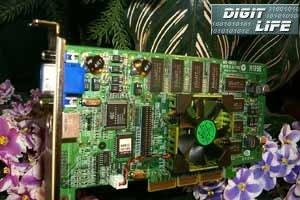  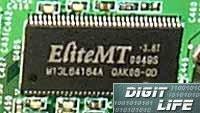 EliteMT produces memory chips with 3.8 ns access time, which corresponds to 260 (520) MHz. Like all other GPU GeForce3 cards, this one works at 200/230 (460) MHz. The memory modules lack for sufficient cooling; heatsinks typical of such fast memory are absent. The card works excellently at the reduced frequency (230 MHz) relatively the rated one (260 MHz). But if the card warms up significantly, especially when the case is closed, it becomes dangerous. It should be noted that the video cards of this trademark of a new revision have appeared on the USA market. They have heatsinks for memory and a more efficient cooler for the processor. Besides, they are equipped with daughter cards with VideoIn-VideoOut. 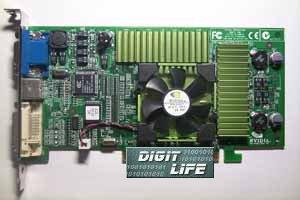 The card is based on the reference design from NVIDIA. The card has a typical square big cooler which consists of a flat heatsink with a fan in the center. But I think this system is less efficient than coolers with fin or pin heatsinks. The heatsink is glued to the chip substantially despite fastening clips provided. It's difficult to say what way of heat transfer is more effective. In my opinion, thermo grease helps to obtain more flexible connection, though less efficient: you can remove a cooler and add/remove thermo grease. The thermo glue provides more effective heat transmission, but the system is less flexible, and there can be air bubbles between the chip and the heatsink. Besides, heatsink are often glued carelessly. This sample is equipped with TV-out (S-Video connector, but the S-Video-to-RCA adapter is supplied together with the card). The card ships in a Retail package. 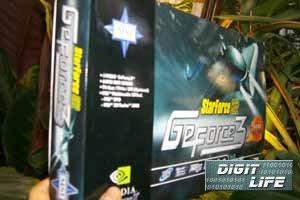  The box contains:
OverclockingDespite the lack of memory heatsinks, the MSI StarForce822 (MS 8822) showed the record level with the additional cooling provided - 250/275 (550) MHz! I was greatly surprised at the frequencies the memory can reach. But do not forget to provide additional cooling in course of overclocking! Installation and driversTest system configuration:
For testing we used drivers from NVIDIA of 12.90 version, VSync was off, S3TC technology was activated. For comparative analyses the results of the following cards are given:
The card is supplied together with the NVIDIA v.12.40 drivers. But as usual, the card from MSI has a proprietary utility 3D!Turbo 2000 which helps in overclocking and in adjusting 2D graphics: 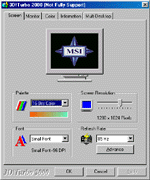 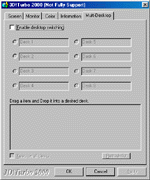 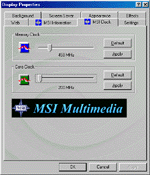 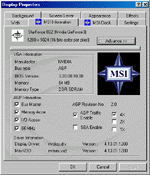 Apart from common settings the 3D!Turbo 2000 allows organizing virtual desktops on the display. Test resultsAs the experience show, cards of this class usually have excellent 2D quality. But you should take into account that 2D quality greatly depends on a definite sample. However, all expensive video cards (GeForce2 Pro and higher) based on the reference design from NVIDIA have much less defects in 2D quality than Low-end cards. The MSI StarForce822 (MS 8822) has quite good 2D quality. But while at 75 Hz in 1600X1200 you can work comfortably, the frequency of 85 Hz won't let you feel relaxedly. Note, though, that a comfortable work can be achieved with a large and high-quality monitor. Sometimes a soapy image is caused not by a video card but by a defective monitor. For estimation of 3D quality we used id Software Quake3 v.1.17 - a game-test which demonstrates the card's operation in OpenGL with usage of a standard benchmark demo002. Quake3 Arenademo002, standard modesThe tests were carried out in two modes: Fast (16-bit color) and High Quality (32-bit color). 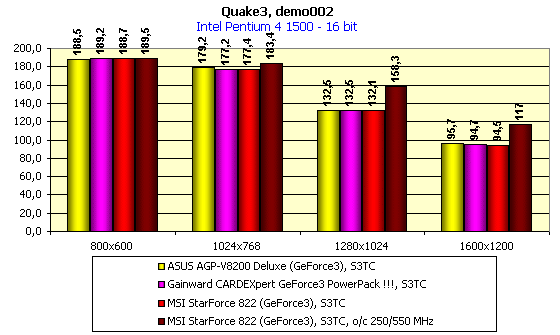  This test shows that this card doesn't differ in the performance from other video cards of this family. For more detailed information on the performance of GeForce3 cards on different platforms refer to our 3Digest. TV-outThe MSI StarForce822 (MS 8822) has a TV-out based on the processor Conexant BT869. The card is equipped with a S-Video connector, but with the S-Video-to-RCA adapter you can connect the TV-out to equipment lacking S-Video connectors. Unfortunately, the TV-out support isn't paid due attention to in NVIDIA's drivers. First of all it concerns video cards with latest chips from Conexant. The BT869 allows displaying an image on a TV screen in 800X600 (at 50-60 Hz, except for dear 100 Hz TV sets). It should be noted that the image quality suffices to watch movies and play games with a TV screen, but you shouldn't use it instead of a monitor because you can ruin your eyesight! ConclusionAlthough this card is an ordinary representative of the GeForce3 family, it has its own advantages. First of all, it's a relatively low price with a rich complete set. But the most important thing is lack of deviation from the reference design. On the one hand, ASUSTeK cards which have their own design show excellent quality and characteristics. On the other hand, there were some abortive attempts when the cards had the design different from the reference one. The worst drawback of this card is lack of memory heatsinks. Besides, there is no a single latest game (it's very strange since a GeForce3 card is, first of all, a gaming card!) The complete characteristics of video cards of this and other classes can be find in our 3Digest. Highs:
Lows:
Write a comment below. No registration needed!
|
Platform · Video · Multimedia · Mobile · Other || About us & Privacy policy · Twitter · Facebook Copyright © Byrds Research & Publishing, Ltd., 1997–2011. All rights reserved. |